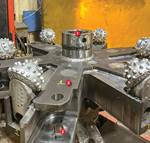Sponsored Video: Helically Interpolating a Hole at 225 IPM Through a Milled Slot
This video demonstrates Dapra's 1" Toroid End Mill executing the helical interpolation of a 1.75" diameter hole to a depth of 1.25". The material is H13, and the machine tool used is a Fadal 4020 with a 40-taper spindle.
Related Content
-
New Modular Tool Options for Small Spindle Milling
Tooling options have been limited for small spindle milling applications. Now modular, indexable systems are available that provide broad flexibility to get the right cutter for the job with less inventory and at lower cost.
-
How to Tackle Tough Angled Pocket Milling With Two Tools
Milling a deep pocket with a tight corner radius comes with unique challenges, but using both a flat bottom drill and a necked-down finishing tool can help.
-
Best Practices: Machining Difficult Materials
Cutting hardened steel, titanium and other difficult materials requires picking the right tools, eliminating spindle runout and relying on best practices to achieve tight part tolerances.







.png;maxWidth=300;quality=90)




